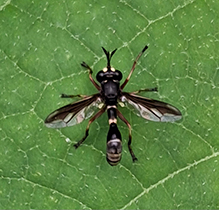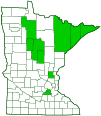thick-headed fly
(Physocephala furcillata)
Conservation • Description • Habitat • Ecology • Distribution • Taxonomy
|
|
||||||||||||||
Description |
Physocephala furcillata is a medium-sized thick-headed fly. It occurs in the United States from Maine to Maryland, west to Minnesota and Ohio. It occurs across southern Canada from Nova Scotia to eastern British Columbia. Adults are active from July to August. They feed on the nectar of flowers. Larvae are thought to be parasitoids, living inside the body of a host bee or wasp and eventually killing it. Adults are ⅜″ to ½″ (10 to 12 mm) in length. The body is black or brownish black (black) with yellowish-white or brownish-yellow (pale) markings, reddish-brown areas, and sometimes red areas. With their narrow-waisted bodies and dark wings they look like wasps, but they also have a superficial resemblance to some hover flies (family Syrphidae). The head is dark, broad, and a little wider than the thorax. The top of the head (vertex) and the back of the head (occiput) are black. There are two large compound eyes and no simple eyes (ocelli). The compound eyes are situated at the sides of the head and do not meet in the middle on either sex. The forehead (frons) is yellow with a dark, T-shaped mark. At the base of the “T”, two black oblique lines extend down on each side bordering the facial ridge. The face is white to yellowish, and it is prominently grooved. The grooves on the facial ridge are pale. The cheeks (genae) are black. On the upper part of the face, there is a narrow, inverted U-shaped mark curling around the antennae bases. The antennae are mostly black and have three segments. They are straight and long, longer than the head, and are projected forward and up. The first and third segments are reddish below. The third segment is inflated and has a slender, elongated process (style) at the tip. The tube-like protruding mouthpart (proboscis) is black. The thorax is black. There is a raised bump (“shoulder pad”) near but not at each front corner. There is a short, small, pale, dash-like mark in the shoulder (humeral) area. It may be indistinct or even absent on some individuals. The exoskeletal plate between the abdomen and the thorax (scutellum) is usually entirely black, but sometimes it has a narrow pale bar. The sides of the thorax are at least partially reddish brown or have thin red lines. The leading (outer) half of each wing is dark and the inner half is clear (hyaline). The thin cell on the leading edge (costal cell) is pale to light brown. Cell r5 is hyaline at the base and for almost the entire length of vein M1. The discal cell is hyaline. The legs are slender and mostly reddish to reddish-brown. On each leg, the third segment (femur) is darker toward the base and pale at the tip. The fourth segment (tibia) is pale on the basal half. The last part of the leg (tarsus), corresponding to the foot, has five segments. The last two segments are black The abdomen is black. Segment 2 and part of segment 3 are very constricted, forming a wasp-like petiole. The petiole is pale on the lower sides, and sometimes the rear is light reddish brown above. Segments 2 through 5 each have a pale band at the rear margin. Segments 4 through 6 have a yellowish-white dusting above. On the female, segment 7 is slender and modified into a pincer-like form. This is thought to be an adaptation that allows the female to pry apart a prey’s abdominal segments and deposit an egg between them. |
Size |
Total length: X¾″ to X¾″ (X to X mm) |
Similar Species |
Habitat |
|
Ecology |
Season |
July to August |
Behavior |
|
Life Cycle |
|
Larva Hosts |
Bees and wasps |
Adult Food |
Flower nectar |
Distribution |
||
|
Sources |
|
| 8/5/2025 | ||
Occurrence |
||
|
||
Taxonomy |
|
Order |
|
Suborder |
Brachycera |
Infraorder |
Cyclorrhapha |
Zoosection |
Schizophora |
Zoosubsection |
Acalyptratae (acalyptrate flies) |
Superfamily |
Conopoidea (kelp, marsh, thick-headed flies, and allies) |
Family |
Conopidae (thick-headed flies) |
Subfamily |
Conopinae |
Tribe |
Physocephalini |
Genus |
Physocephala |
Subordinate Taxa |
|
|
|
Synonyms |
|
Conops furcillatus Physocephala lucida |
|
Common Names |
|
This species has no common name. The common name for the family Conopidae is thick-headed flies, and it is applied here for convenience. |
|
Glossary
Femur
On insects and arachnids, the third, largest, most robust segment of the leg, coming immediately before the tibia. On humans, the thigh bone.
Frons
The upper front part of an insect’s face, roughly corresponding to the forehead.
Gena
In insects: The area between the compound eye and the mandible; the cheek. In birds: The area between the the angle of the jaw and the bill; the feathered side (outside) of the under mandible. Plural: genae.
Hyaline
In plants: Thin, membranous, and translucent or transparent. In insect wings: Transparent and colorless or nearly colorless and often with a glassy appearance.
Occiput
The back of the head. In Odonata, Megaloptera, and Neuroptera, the upper part of the head behind the eyes.
Ocellus
Simple eye; an eye with a single lens. Plural: ocelli.
Petiole
On plants: The stalk of a leaf blade or a compound leaf that attaches it to the stem. On ants and wasps: The constricted first one or two segments of the rear part of the body.
Proboscis
The tube-like protruding mouthpart(s) of a sucking insect.
Scutellum
The exoskeletal plate covering the rearward (posterior) part of the middle segment of the thorax in some insects. In Coleoptera, Hemiptera, and Homoptera, the dorsal, often triangular plate behind the pronotum and between the bases of the front wings. In Diptera, the exoskeletal plate between the abdomen and the thorax.
Style
On plants: Part of the pistil, usually a slender stalk, connecting the ovary to the stigma(s). On flies (Diptera): A terminal, often slender or pointed, appendage arising from the end of the last, usually third, antennal segment.
Vertex
The upper surface of an insect’s head.
Visitor Photos |
||
Share your photo of this insect. |
||
This button not working for you? |
||
Luciearl |
 |
MinnesotaSeasons.com Photos |
||
|
||
|
||

Slideshows |
|

Visitor Videos |
||
Share your video of this insect. |
||
This button not working for you? |
||
|
Other Videos |
||
Physocephala furcillata - 2020/07/23 |
About
Jul 23, 2020 |

|
Created: 8/5/2025 Last Updated: © MinnesotaSeasons.com. All rights reserved. |


